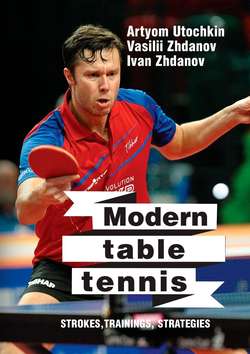Читать книгу Modern table tennis: strokes, trainings, strategies - Artyom Utochkin - Страница 12
Different variations of the forehand top-spin
Variation #3. Chopped forehand top-spin
ОглавлениеChopped forehand top-spin is a variation that is learned after mastering the forehand topspin/loop against the block. It is learned as a second element because it is more difficult to perform.
Mastering of this variation is critical to the level of playing table tennis. Not owning this variation at all (or enough), it is impossible to achieve any result.
80% of attacks begins with this element in the table
tennis. Mastering (or not) this top-spin variation largely determines the ability of the athlete to play at some level.
Forehand chop is different from the forehand loop against the block by four main criteria:
– Swing.
– The movement width.
– Racket tilt.
– The direction of movement.
During the backswing, the racket is lowered much below to create a large amplitude of movement necessary to give the ball a good spin at the lower spin of the opponent.
And the hand with the racket not just falls below, this happens due to the right leg being more bent, a bigger turn of the pelvis and the greater extension of the arms at the elbow.
Together, all this provides a greater width of the movement, which is necessary to perform a complete chopped top-spin.
The movement is broader because at the top-spin from the block we are dealing with a ball that is spinning in a direction that is convenient for us. The speed of its flight contributes to our top-spin speed. Roughly speaking, the faster the ball flies off the block, the more speed our top-spin has. The whole block speed is converted during our top-spin.
With a chopped top-spin the ball spins in the other direction, and we need to cut off its rotation, and add its own rotation.
In other words, the chopped forehand top-spin requires significantly more effort than top-spin against the block. The wider movement is necessary to ensure this effort.
The tilt of the racket at the chopped top-spin is more open. Because if we play the ball with the same tilt of rackets, as in case of the top-spin against the block, the ball would get into a net with a great probability. It would lack enough trajectory to fly over the net. And trajectory reserve is attached to a ball due to a good rotation.
Movement direction at the chopped top-spin is different from top-spin against the block significantly due to the greater thrust up.
Here works the same principle as with the tilting of the racket. I.e. if you send motion too forward, the ball most likely would get into the net.
The end of the movement is also slightly higher. The higher the position of the racket is provided by the previous components: width and direction, more open racket tilt.
